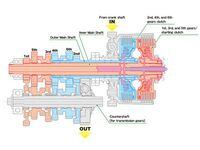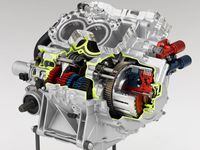Contrary to information presented in our current print issue ("Techno-Force!" October 2009, 14), the 2010 Honda VFR1200 will indeed offer automatic shifting via Honda's Dual Clutch Transmission (HDCT), which debuts on this model. Don't confuse this revolutionary new gearbox with the continuously variable "Human Friendly Transmission" fitted to Honda's DN-01. The HDCT has more in common with a traditional six-speed manual transmission, and offers performance and benefits more in line with the character and demands of traditional, high-performance sportbikes.
The Dual Clutch name describes the two separate, computer-controlled, hydraulically actuated clutch units that operate synchronously to provide automatic upshifts and downshifts between six gears. A control on the right switchgear toggles between three operating modes: fully automatic D-mode for regular operation; fully automatic S-Mode for sport riding; or a six-speed "Manual" mode. "Semi-automatic" seems a more accurate description of the Manual mode, however, as there is no clutch lever and clutch action remains computer controlled. Manual mode simply lets the rider choose the shift points independently, utilizing forefinger and thumb paddles on the left switchgear initiate gear changes.
Does this seem confusing? It's not-this video illustrates the Dual Clutch Transmission in action, showing both full automatic and manual operation:
The HDCT utilizes two separate clutches for the odd gears (first, third and fifth) and the even gears (second, fourth and sixth), respectively. The two clutches operate alternately to execute gear changes. When the computer recognizes the need to upshift (either automatically after reaching a preset value, or in response to a manual paddle input), it engages second gear and releases the first-gear clutch while simultaneously engaging the second-gear clutch to achieve a seamless gear change. This ability to instantaneously transfer torque from one gear to the next will enable quicker and smoother gear changes, better fuel economy and reduced emissions, Honda says. We can envision definite performance benefits to the rider as well, especially during aggressive cornering. Seamless power transfer between gears will minimize abrupt acceleration or deceleration inputs that could compromise traction, especially entering or exiting corners. Theoretically, midcorner gear changes-even at the apex, even under power-would be imperceptible except for the change in exhaust note.
Honda reports it has more than 100 patents pending on the Dual Clutch Transmission. Dual input shafts, the exclusive inline clutch design and advanced hydraulic circuitry are just a few of the innovations that allow an exceptionally compact design that can be grafted onto an existing engine and fitted into a conventional chassis without substantial layout changes. Does this mean we'll be seeing auto-shift CBRs in the near future? Don't be surprised-Honda says it intends to "expand the deployment of the new transmission to more and more of its large-displacement motorcycles, particularly sports models destined for use in developed countries." Sounds like the 2011 CBR1000RR, to us.
Honda claims its Dual Clutch Transmission provides easier, more-reliable operation without sacrificing the interactive shifting sensation that sport riders expect. Due to the unique benefits and features, this could turn out to be the most functional automatic motorcycle transmission yet-and, perhaps, the first one ever that sportbike riders would consider acceptable for use.












/cloudfront-us-east-1.images.arcpublishing.com/octane/HXOUJXQWA5HBHGRO3EMJIGFMVI.jpg)

/cloudfront-us-east-1.images.arcpublishing.com/octane/3TIWWRV4JBBOLDVGRYECVVTA7Y.jpg)
/cloudfront-us-east-1.images.arcpublishing.com/octane/KIX5O23D5NAIBGFXBN3327DKZU.jpg)
/cloudfront-us-east-1.images.arcpublishing.com/octane/7GJYDUIPXRGMTMQKN6ONYOLBOU.jpg)
/cloudfront-us-east-1.images.arcpublishing.com/octane/MUQLOVLL2ZDGFH25ILABNBXKTI.jpg)
/cloudfront-us-east-1.images.arcpublishing.com/octane/TNOU5DNE2BC57MFPMGN2EIDXAM.jpg)
/cloudfront-us-east-1.images.arcpublishing.com/octane/GTCXACQGJ5HAPDTGWUQKDEH44E.jpg)
/cloudfront-us-east-1.images.arcpublishing.com/octane/S35YGSEMEZB4BLTDJTSZPF4GLA.jpg)
/cloudfront-us-east-1.images.arcpublishing.com/octane/5UOT6HPX2JFMRJAX6EH45AR4MQ.jpg)
/cloudfront-us-east-1.images.arcpublishing.com/octane/OKWOJWAKP5EP3OACCRRWPCIX2Q.jpg)
/cloudfront-us-east-1.images.arcpublishing.com/octane/2WF3SCE3NFBQXLDNJM7KMXA45E.jpg)
/cloudfront-us-east-1.images.arcpublishing.com/octane/G4MG6OUCJNBSHIS2MVVOTPX65E.jpg)
/cloudfront-us-east-1.images.arcpublishing.com/octane/IIGGWFOTOJGB7DB6DGBXCCMTDY.jpg)
/cloudfront-us-east-1.images.arcpublishing.com/octane/QSTCM6AVEZA5JJBUXNIQ3DSOF4.jpg)
/cloudfront-us-east-1.images.arcpublishing.com/octane/U4I7G625B5DMLF2DVIJDFZVV6M.jpg)
/cloudfront-us-east-1.images.arcpublishing.com/octane/B6XD6LS6IVCQPIU6HXDJSM3FHY.jpg)
/cloudfront-us-east-1.images.arcpublishing.com/octane/ICL63FEDDRDTTMINYICCEYGMDA.jpg)
/cloudfront-us-east-1.images.arcpublishing.com/octane/FCGZHQXRBZFLBAPC5SDIQLVF4I.jpg)
/cloudfront-us-east-1.images.arcpublishing.com/octane/WNOB6LDOIFFHJKPSVIWDYUGOPM.jpg)

/cloudfront-us-east-1.images.arcpublishing.com/octane/X33NU3E525ECRHXLNUJN2FTRKI.jpg)
/cloudfront-us-east-1.images.arcpublishing.com/octane/6KKT5NNL2JAVBOXMZYS5ZO76YA.jpg)
/cloudfront-us-east-1.images.arcpublishing.com/octane/J5RKG5O455GMPGQRF2OG6LRT7A.jpg)